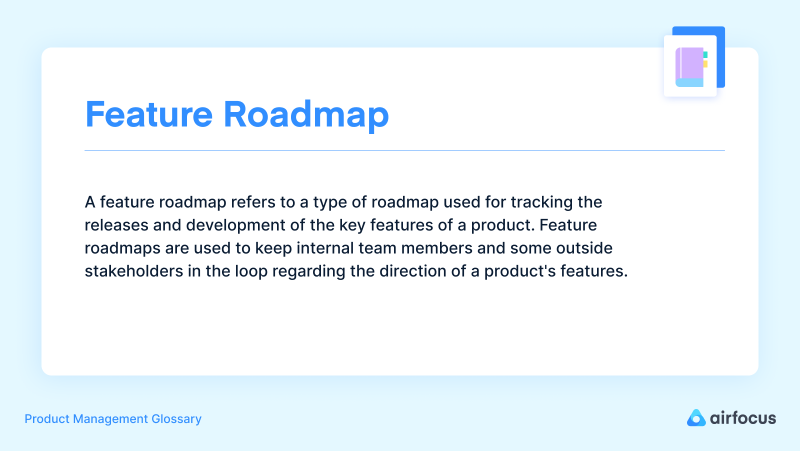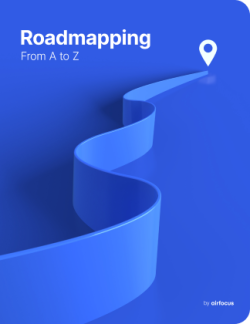Feature Roadmap
What is a feature roadmap?
Feature roadmap definition
A feature roadmap refers to a type of roadmap used for tracking the releases and development of the key features of a product. Feature roadmaps are used to keep internal team members and some outside stakeholders in the loop regarding the direction of a product's features.
Feature roadmaps allow for key releases to be prioritized and resource distribution to be managed in development cycles. This way, the feature roadmap provides a snapshot illustration of how a product is going to develop without delving into specifics about other aspects of a company. This retains the emphasis on initiatives that benefit users.
10 benefits of using a feature roadmap
Feature roadmapping provides numerous advantages. For one, it supports product managers and fosters teamwork within the development team. It also provides stakeholders with a clear picture of the road ahead and guarantees that users are getting the features and product functionality that really meets their needs.
An effective feature roadmap can be a great tool that comes with benefits, such as:
Facilitates team alignment regarding product features.
Gives the most important prioritizations a clear visual representation.
Makes sure you quickly achieve short-term product goals while tracking and revising long-term objectives.
Coordinates the team members on the most critical tasks.
Monitors release dates and the launch of a specific product.
Maintains the business goals and the general product vision.
Enables stakeholders to offer feedback and view the most updated version of your product plan.
Helps you identify and solve issues at any given moment in a quick manner.
Prevents your company from becoming a feature factory.
Feature roadmap example
Let's say there are three features you want to add to a scheduling app. Those features are:
A calendar
The ability to tag coworkers in the calendar
The ability to drag and drop events within the calendar
Ideally, you'll want the features to go live in this order. So, on your feature roadmap, you'll create three horizontal lanes, one for each of these features.
Then, you'll create columns for the lanes that assess how far along you are in implementing these features, from prototyping to launch.
And that's a basic example of what a feature roadmap might look like. It shows all of the features you want to add at once, prioritizes them, and lets you know the progress you’ve made and the progress that still needs to happen.
Feature roadmap templates
Objective-led roadmap
When building a feature roadmap, you can follow a few different templates depending on your goals, workflows, and needs. The first kind of template you can follow is an objective-led roadmap.
An objective-led roadmap is a goal-oriented feature roadmap. Rather than thinking about features, you're considering problems that need to be solved, answering feature requests and complaints, and so on.
Technology roadmap
A technology roadmap, on the other hand, focuses on the specific technologies you will implement and provide to your users. Here, the emphasis is on launching cutting-edge and engaging content for your customers.
This is great for teams in a particularly competitive sector, those that have just launched a new product, or if your user base is excited about bleeding-edge tech.
Outcome-based roadmap
Outcome-based roadmaps focus on the scenarios and goals you want to achieve with your product rather than the specific features involved.
For example, you might think about how you want your product to be used and who your users might be before you even start thinking of specific features. Your roadmap will be successful when you make these visions happen.
Why outcome-based roadmaps are better than feature roadmaps
Helps you avoid being a "feature factory"
The first major benefit of outcome-based roadmaps over feature roadmaps is that they help you avoid becoming a feature factory.
A feature factory is a business that prioritizes putting new features out over ensuring that each added feature is an important and valuable feature. In other words, it's quantity over quality.
When you lean on outcome-based roadmaps, you focus on creating quality updates rather than plentiful ones. That means fewer bugs, a less overworked team, and, ultimately, happier users.
Why is it better to avoid being a feature factory? One word: user-centricity. If you’re shoving new features into your product too regularly, you might be overlooking the actual value of these features to users.
Learn more about avoiding the feature factory phenomenon in our ebook here.
Puts more focus on meeting your goals
Another benefit of outcome-based roadmaps over feature roadmaps is that they emphasize meeting (or even surpassing) your goals rather than increasing your output.
Of course, everyone wants to be the company that can churn out tons of great features all the time, leaving the competition in the dust. But this approach can lead to poorly executed goals or abandoned goals altogether. Features come out half-baked and unprepared for regular use. And they don’t improve over time.
An outcome-based roadmap helps you avoid this issue. It can help your team set more realistic goals and better prioritize.
Your roadmap is less likely to turn into an obligation
The last benefit of outcome-based roadmaps over feature roadmaps is that they're less likely to become an obligation. With feature roadmaps, it can sometimes feel like getting the feature out is the most important thing in the world. After all, that's what the roadmap is telling you, right?
The problem with this is clear. Launching new features isn't all that important. Sure, you should be releasing new features occasionally. But they should be great features, not mediocre features to help you rack up points on an imaginary feature scoreboard.
Outcome-based roadmaps help you stay on track. It's easier to ditch a feature that simply isn't working, to focus on quality over quantity, and to emphasize creating the best possible product for your users.

General FAQ

Glossary categories
Build great roadmaps

Experience the new way of doing product management







